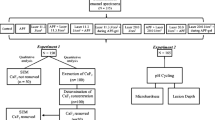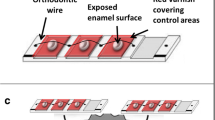Abstract
The aim of this in-vitro study was to evaluate positive effects of the carbon dioxide laser (CO2, 10,600 nm) with acidulated phosphate fluoride (APF) gel on enamel acid resistance. Twenty extracted human third molars (40 surfaces) were randomly assigned into four groups: group C, untreated control; group L, CO2 laser alone group; group F, APF 1.23% fluoride gel; and group FL, APF 1.23% gel and laser. Samples from group L were irradiated with a CO2 laser for 30s. The parameter settings used were average power, 0.73 W; time on, 100 μs; time off, 40 ms; tip-to-tissue distance, 20 mm; tip diameter 700 μm; and energy density with movements, 5 J/cm2. Samples from group F were treated with the APF gel for 4 min, and the gel was washed off with distilled water. The enamel samples from group FL were treated with APF gel for 4 min and then irradiated with the CO2 laser for 30s without removing the gel. Each enamel sample was placed in 50 ml soft drink (pH = 2.75) for 10 min then rinsed with deionized water and stored in artificial saliva at 37 °C for 1 h. Samples were assessed for Vickers hardness number (VHN) before and after treatments and subjected to SEM analysis. Data were analyzed using a one-way analysis of variance (ANOVA) and Tukey’s test (α < 0.05). After the acid challenge, the untreated C group was demineralized to a great extent and the enamel surface was with the lowest mean score of microhardness. The observed VHN in the control (C group) had a mean value of 176.13, the scores in the CO2 laser group (L group) were with mean value of 238.40, the F group with a mean value of 218.45, and the fluoride-treated and laser-irradiated FL group—with a mean of 268.28 VHN. Paired t test performed to compare groups C, L, F, and FL has shown that group FL has greater resistance to decrease in microhardness of dental enamel (P ≤ 0.05) on exposure to acidic protocol. After the acid challenge, the fluoride-treated and laser-irradiated samples (group FL) showed the least diminution in enamel surface microhardness. The sub-ablative carbon dioxide laser irradiation in combination with fluoride treatment is more effective in protecting enamel surface and resisting demineralization than CO2 laser irradiation or fluoride alone.








Similar content being viewed by others
References
Attin T, Koidl U, Buchalla W et al (1997) Correlation of microhardness and wear of differently eroded enamel. Arch Oral Biol 42:243–250
Bartlett DW, Blunt L, Smith BG (1997) Measurement of tooth wear in patients with palatal erosion. Br Dent J 182:179–184
Lussi A, Schaffner M (2000) Progression of and risk factors for dental erosion and wedge-shaped defects over a 6-year period. Caries Res 34:182–187
Ganss C, Klimek J, Giese K (2001) Dental erosion in children and adolescents-a cross-sectional and longitudinal investigation using study models. Community Dent Oral Epidemiol 29:264–271
Lussi A, Jaeggi T, Schaffner M (2002) Diet and dental erosion. Nutrition 18:780–781
Millward A, Shaw L, Smith AJ et al (1994) The distribution and severity of tooth wear and the relationship between erosion and dietary constituents in a group of children. Int J Paediatr Dent 4:152–157
Ganss C, Schlueter N, Hardt M et al (2008) Effect of fluoride compounds on enamel erosion in vitro: a comparison of amine, sodium and stannous fluoride. Caries Res 42(1):2–7
Wiegand A, Magalhães AC, Navarro RS et al (2010) Effect of titanium tetrafluoride and amine fluoride treatment combined with carbon dioxide lase irradiation on enamel and dentin erosion. Photomed Laser Surg 28(2):219–226
Marthaler TM (2004) Changes in dental caries 1953–2003. Caries Res 38:173–181
Lima YBO, Cury JA (2003) Seasonal variation of fluoride intake by children in a subtropical region. Caries Res 37:335–338
Yu H, Attin T, Wiegand A et al (2010) Effects of various fluoride solutions on enamel erosion in vitro. Caries Res 44(4):390–401
Hove LH, Holme B, Young A et al (2007) The erosion-inhibiting effect of TiF4, SnF2, and NaF solutions on pellicle-covered enamel in vitro. Acta Odontol Scand 65(5):259–264
Hove LH, Holme B, Young A et al (2008) The protective effect of TiF4, SnF2 and NaF against erosion-like lesions in situ. Caries Res 42(1):68–72
van Rijkom H, Ruben J, Vieira A et al (2003) Erosion-inhibiting effect of sodium fluoride and titanium tetrafluoride treatment in vitro. Eur J Oral Sci 111(3):253–257
Büyükyilmaz T, Ogaard B, Rolla G (1997) The resistance of titanium tetrafluoride-treated enamel to strong hydrochloric acid. Eur J Oral Sci 105:473–477
Schlueter N, Ganss C, Mueller U et al (2007) Effect of titanium tetrafluoride and sodium fluoride on erosion progression in enamel and dentine in vitro. Caries Res 41(2):14–45
Vlacic J, Meyers IA, Walsh LJ (2007) Laser-activated fluoride treatment of enamel as prevention against erosion. Aust Dent J 52(3):175–180
Zero DT, Lussi A (2005) Erosion—chemical and biological factors of importance to the dental practitioner. Int Dent J 55(4 Suppl 1):285–290
Harris NO, Garcia-Goday F, Nathe CN (2008) Primary preventive dentistry 7th ed. New Jersey: Pearson Higher Ed 6(9):246–251
Featherstone JDB, Nelson DGA (1987) Laser effects on dental hard tissue. Adv Dent Res 1:21–26
Takahashi K, Kimura Y, Matsumoto K (1998) Morphological and atomic analytical changes after CO2 laser irradiation emitted at 9.3 μm on human dental hard tissue. J Clin Laser Med Surg 16:167–173
Hossain MM, Hossain M, Kimura Y et al (2002) Acquired acid resistance of enamel and dentin by CO2 laser irradiation with sodium fluoride solution. J Clin Laser Med Surg 20(2):77–82
Yamashita JM, Torres NM, Moura-Grec PG et al (2013) Role of arginine and fluoride in the prevention of eroded enamel: an in vitro model. Aust Dent J 58:478–482
Klocke A, Mihailova B, Zhang S et al (2007) CO2 laser-induced zonation in dental enamel: a Raman and IR microspectroscopic study. J Biomed Mater Res B Appl Biomater 81(2):499–507
Mirhashemi AH, Hakimi S, Ahmad Akhoundi MS et al (2016) Prevention of enamel adjacent to bracket demineralization following carbon dioxide laser radiation and titanium tetra fluoride solution treatment: an in vitro study. J Lasers Med Sci 7(3):192–196
Lepri TP, Colucci V, Turssi CP et al (2015) In situ investigation of the effect of TiF4 and CO2 laser irradiation on the permeability of eroded enamel. Arch Oral Biol 60(6):941–947
Holcomb DW, Young RA (1980) Thermal decomposition of human tooth enamel. Calcif Tissue Int 31:189–201
Kuroda S, Fowler BO (1984) Compositional, structural, and phase changes in in vitro laser-irradiated human tooth enamel. Calcif Tissue Int 36(4):361–369
Tagomori S, Morioka T (1989) Combined effects of laser and fluoride on acid resistance of human dental enamel. Caries Res 23(4):225–231
Correa-Afonso AM, Pécora JD, Palma-Dibb RG (2013) Influence of laser irradiation on pits and fissures: an in situ study. Photomed Laser Surg 31(2):82–89
Paulos RS, Seino PY, Fukushima KA, Marques MM, de Almeida FCS, Ramalho KM, de Freitas PM, Brugnera A Jr, Moreira MS (2017) Effect of Nd:YAG and CO2 laser irradiation on prevention of enamel demineralization in orthodontics: in vitro study. Photomed Laser Surg 35(5):282–286
Jeng YR, Lin TT, Huang JS et al (2013) Topical laser application enhances enamel fluoride uptake and tribological properties. J Dent Res 92(7):655–660
Vieira KA, Steiner-Oliveira C, Soares LE et al (2015) In vitro evaluation of enamel demineralization after several overlapping CO2 laser applications. Lasers Med Sci 30(2):901–907
Schmidlin PR, Dorig I, Lussi A et al (2007) CO2 laser-irradiation through topically applied fluoride increases acid resistance of demineralised human enamel in vitro. Oral Health Prev Dent 5(3):201–208
Kantorowitz Z, Featherstone JD, Fried D (1998) Caries prevention by CO2 laser treatment: dependency on the number of pulses used. J Am Dent Assoc 129(5):585–591
Fried D, Ragadio J, Champion A (2001) Residual heat deposition in dental enamel during IR laser ablation at 2.79, 2.94, 9.6, and 10.6 μm. Lasers Surg Med 29(3):221–229
Fried D, Murray M, Featherstone JDB et al (1999) Dental hard tissue modification and removal using sealed TEA lasers operating at λ = 9.6 and 10.6 μm. Lasers in Dentistry V. Proceeding of the SPIE Meeting, San Jose. Washington, Bellingham
Klein A, Rodrigues L, Eduardo C et al (2005) Caries inhibition around composite restorations by pulsed carbon dioxide laser application. Eur J Oral Sci 113(3):239–244
Steiner-Oliveira C, Rodrigues LK, Soares LE et al (2006) Chemical, morphological and thermal effects of 10.6-microm CO2 laser on the inhibition of enamel demineralization. Dent Mater J 25(3):455–462
Zuerlein MJ, Fried D, Featherstone JD (1999) Modeling the modification depth of carbon dioxide laser-treated dental enamel. Lasers Surg Med 25(4):335–347
Wu CC, Roan RT, Chen JH (2002) Sintering mechanism of the CaF2 on hydroxyapatite by a 10.6-lμm CO2 laser. Lasers Surg Med 31:333–338
Passos VF, Melo MA, Silva FF et al (2014) Effects of diode laser therapy and stannous fluoride on dentin resistance under different erosive acid attacks. Photomed Laser Surg 32:146–151
Steiner-Oliveira C, Nobre-dos-Santos M, Zero DT et al (2010) Effect of a pulsed CO2 laser and fluoride on the prevention of enamel and dentine erosion. Arch Oral Biol 55(2):127–133
Acknowledgements
The study was undertaken within the research global budget for the Medical University of Plovdiv, Bulgaria.
Consent was not required owing to the anonymous nature of the sourcing of teeth extracted for oral surgery purposes at Medical University, Plovdiv, Bulgaria.
Author information
Authors and Affiliations
Corresponding author
Ethics declarations
Conflict of interest
The authors declare that they have no conflicts of interest.
Rights and permissions
About this article
Cite this article
Belcheva, A., El Feghali, R., Nihtianova, T. et al. Effect of the carbon dioxide 10,600-nm laser and topical fluoride gel application on enamel microstructure and microhardness after acid challenge: an in vitro study. Lasers Med Sci 33, 1009–1017 (2018). https://doi.org/10.1007/s10103-018-2446-4
Received:
Accepted:
Published:
Issue Date:
DOI: https://doi.org/10.1007/s10103-018-2446-4




